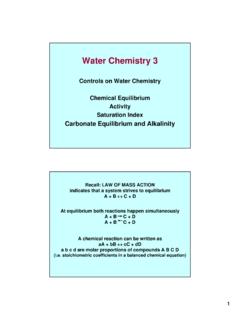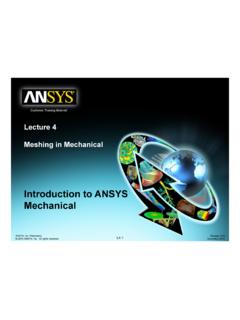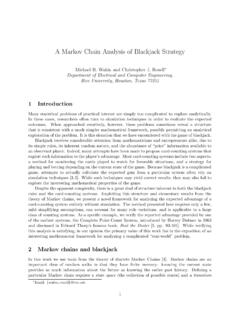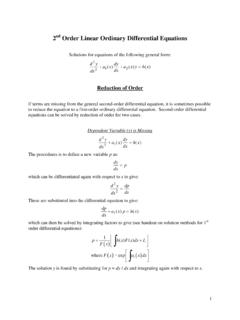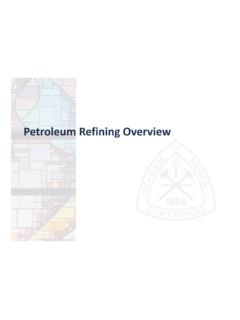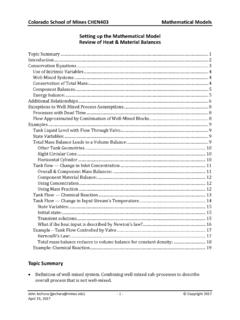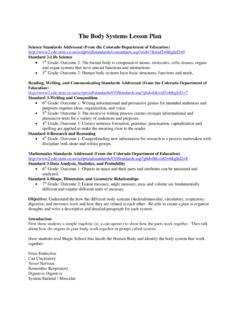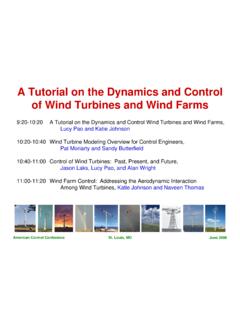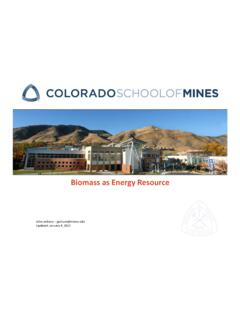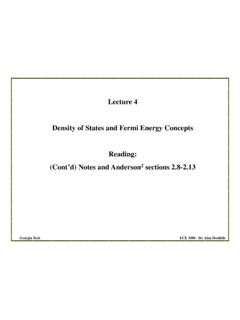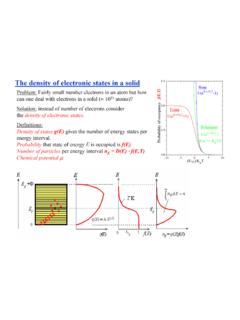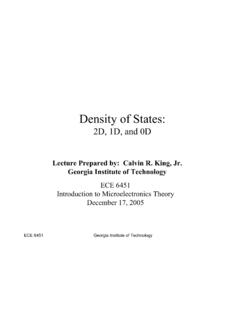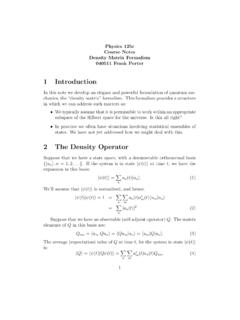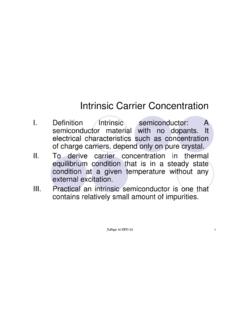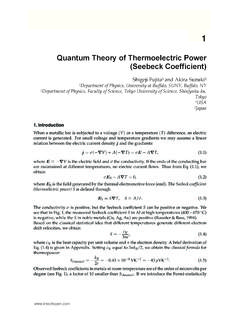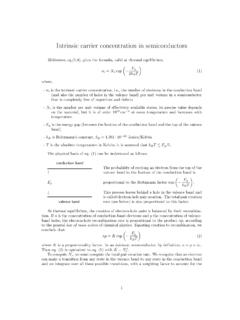Transcription of Liouville’s Theorem - Inside Mines
1 liouville s TheoremPHGN 505 ReportbyMarc DvorakDecember 2, 2011 Prof. Tim OhnoColorado School of Mines1 Introduction and Basic FormulationLiouville s Theorem describes the evolution of the distribution function in phase space for aHamiltonian system. It is a fundamental theory in classical mechanics and has a straight-forward generalization to quantum systems. The basic idea of liouville s Theorem can bepresented in a basic, geometric fashion. The mathematical derivation is also rather straight-forward. liouville s Theorem applies to all Hamiltonian systems with number of single particle case is important but rather boring. The Theorem becomes more im-portant in classical statistical mechanics as the particle number becomes very large. Inparticular, liouville s Theorem , along with its partners ergodicity, entropy, and Poincare srecurrence Theorem , describe the equilibration and fluctuations of a dynamical system.
2 Thisreport is based in classical mechanics, but because of the utility of liouville s Theorem inmany particle physics, it includes many ideas from statistical mechanics. References [3] [5][4] [2] [1] are listed in arbitrary in a Hamltionian system can be described by their position in phase space, the6 Ndimensional space with 3 coordinate axes and 3 momentum axes. A particle s locationin phase space is equivalent to specifying its position and momentum. Trajectories throughphase space, then, are the dynamical paths taken by particles in the system. Because phasespace is cartesian, its volume element can be writtendVPhase=dxdy dz dpxdpydpzwithunitsm3(Ns)3. The distribution functionf(r,p,t) relates phase space volume elements tothe number of particles in that volume. In differential form, this takes the formdN=f(r,p,t)dxdy dz dpxdpydpz=f(r,p,t)d3xd3p(1)Again, the distribution functionfis the number of volume elements occupying the differentialphase space s Theorem is concerned with the time evolution of distribution functions.
3 Westart this discussion by considering the simplest case of a collection free particles. If the initialconditions of the problem dictate that the occupied volume in phase space is a hypercube,how does the system evolve? states farthest from the origin in the direction of momentumwill shift the most as the system evolves. This is not due to any external forces, only theinitial conditions causing the hypercube to distort. states closer to the origin will shiftless, and the cube will be a distorted 6 dimensional parallelogram with its center shiftedalong the position axes from its initial position. As certain corners of the distribution shiftfurther from each other, opposite pairs of corners shift closer together. The distribution iseffectively stretched in the direction with the greatest initial momentum. The volume ofthis occupied phase space element is constant, however.
4 Because no particles have beencreated or destroyed, we can also say the density of the occupied element is constant. Thistransformation is displayed graphically in Fig. 1. The previous example can be generalizedto include conservative forces. As the initial hypercube is allowed to evolve, the momentumis no longer constant, and the center of the element is able to shift along all position andmomentum axes. The displacement vector from the initial center to the time dependentcenter is not particularly meaningful - there is no meaningful metric in phase space. Thehypercube can shift in all directions, though, and will now distort based on the strength ofthe forces in the three directions and the initial momentum in each direction. The volume,particle number, and phase space density all remain constant as in the zero force 1: Displacement in phase space of an initial hypercube subject to zero (a) and constant(b) constant density of particles in phase space is one loosely worded version of liouville Derivation of Boltzmann Equation and liouville sTheoremContinuity equations describe the rate of change of particles at a point in space as a functionof the particle velocities, density gradients, forces, and any particle sources or sinks.
5 Firstconsider the steady flow of a fluid through space. The total number of particles in a closedsurface is found by integrating the particle density over the volume of the surface. For thenumber of particles in the volume to change in time, there must be a net flux of particlesin or out of the surface. Integrating the velocity at any time over the surface of the spheregives the following relation N t= nv dS(2)wherenis the particle density . After applying Gauss Theorem , one obtains the well knowncontinuity equation. n t= (nvb)(3)The rate of change of the density depends on the sources of particles. This can be straight-forwardly generalized to 6 Ndimensional phase space by replacing with a 6 dimensionaldivergence - 3 coordinate and 3 momentum derivatives. Expanding the derivatives gives f t= v f f v F pf f p F(4)The vterm can be discarded.
6 This divergence is three partial derivatives over position,keeping all other variable constant. Since thepiare held constant, theviare as well andthis term is zero. We discard another term in this equation with the common restriction ofconservative systems. If the p-divergence of the force is zero, we can discard the fourth termon the right side. In other words, the force cannot depend on momentum, conservative2forces only from this point on in the derivation. Adding a collision term of the form f/ tgives the Boltzmann transport equation, which is useful in its own right. Excluding thecollision term will lead to liouville s Theorem , however. Generalizing the remaining termsto multiple particles, and recognizing the velocity asdx/dtand force asdp/dt, one gets theLiouville equation. f t+ i f xidxidt+ i f pidpidt= 0(5)Eq. 5 can be recognized as the total derivative of the distribution functionf.
7 Indeed, Liou-ville s Theorem says the density of a vanishingly small element of phase space is conserved intime as it is followed around a phase space trajectory. The partial derivative equates explicittime changes in the distribution function to the forces on the system and the instantaneousvelocities - this is true if one observes a fixed surface in phase space and allows density toflow through it. The total derivative, on the other hand, tracks the time evolution of thecoordinates as well, not only the distribution function. Thus, liouville s Theorem states thatthe phase space density of a certain elementas it moves in phase spaceis fixed,df/dt= can return to the geometric argument presented in the first section as well. Conser-vation of particles in phase space requiresddt(f(r,p,t)d3xd3p) = 0(6)Applying the chain rule to the derivative above, we see thatddtd3xd3p= 0 sincefcan takearbitrary values.
8 This alternative statement of liouville s Theorem is that the volume occu-pied by a given set of particles is conserved as one tracks the particles through phase is exactly the conclusion drawn from the simple hypercube evolution in the previoussection. These two definitions can be combined as the condition of incompressible flow inphase space. Analogously and perhaps more intuitively in fluid mechanics, incompressibleflow occurs under the conditiond /dt= 0 for density . This behavior can be seen in eitherstatement of liouville s Theorem - small volumes in phase space can be twisted and stretched,but can never be Alternative DerivationPhase space is the 6 Ndimensional space describing the position and momentum of each oftheNparticles of a dynamical system. At any timet, the system is wholly described byits configuration in phase space, denotedP(~q,~p) for 3 Ndimensional vectors~qand~p.
9 Ata later timet , the system will evolve to a new configurationP(~q ,~p ) given by integratingHamilton s equations. In this manner, the new phase space coordinates~q and~p can beconsidered a function of the previous coordinates att. The phase space volume elements atdifferent times can be related by Eq. =J(t,t )dV(7)J(t,t ) is the Jacobian determinant of the transformation, (t,t ) = (~qk , ~pk ) (~qi, ~pi)(8)3J(t,t ) uses the transformations of individual coordinates to describe the transformation ofthe entire volume elementdV. Ift=t , then~pk=~pk and~qk=~qk , meaning only thediagonal elemements of the Jacobian matrix survive. This leaves the identityJ(t,t) = 1, apleasing lett =t+dtand keep terms first order indt. Hamilton s equations give thefollowing. pk=dpkdt= H qk(9) qk=dqkdt= H pk(10)p k=pk H qkdt(11)q k=qk+ H pkdt(12)Evaluating the determinant in Eq.
10 7 to first order indtto getJ(t,t+dt) gives Eq. (t,t+dt) 1 + k( 2H pkqk 2H pkqk)dt= 1(13)J(t,t+dt) =J(t,t) + tJ(t ,t) t =tdt= 1(14)The second line in Eq. 4 is a simple taylor expansion for infinitesimal distancedtaway fromtimet. We previously showed thatJ(t,t) = 1. Together, these results tell us that tJ(t ,t) t =t= 0(15)This is a key element in this derivation of liouville s Theorem . Remembering thatJ(t,t )describes the transformation of some phase space volume fromdVtodV , we can write acomposite transformation as a product ofJ =J(t,t )J(t ,t )dV=J(t,t )dV(16)The composite transformation can be writtenJ(t,t ) =J(t,t )J(t ,t ). Now take the deriva-tive ofJ(t,t ) with respect tot and evaluate att =t . J(t,t ) t =J(t,t ) t J(t ,t ) t =t (17)Eq. 15 implies that the partial derivative on the right side of Eq. 17 is zero, since Eq.
